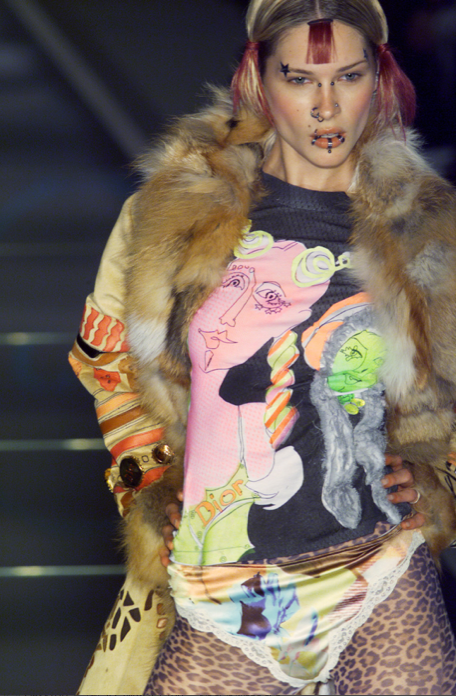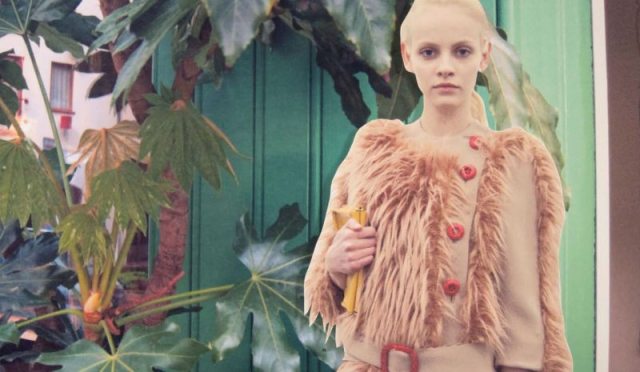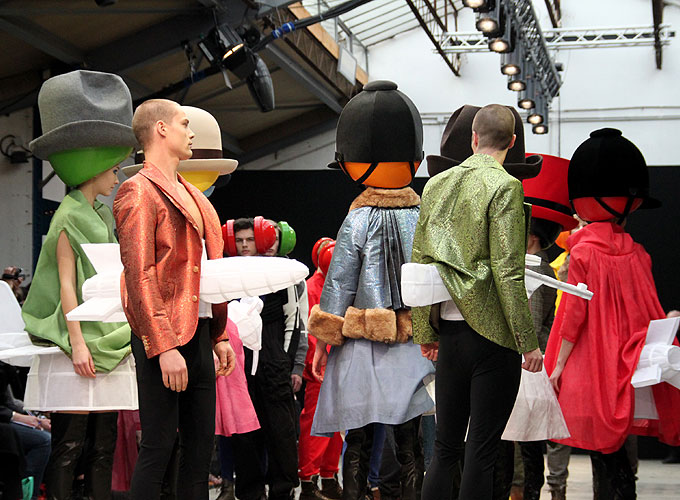‘Ugliness is the devil’s grin behind beauty’
– Victor Hugo
AGAINST AN OVER-SATURATION OF images and information, our aesthetic judgments are complicated by the coexistence of ‘beauty’ and ‘ugliness’ within contemporary fashion. At this intersection emerges ‘good-bad’ taste, identified here as an eclectic montage of formal qualities1 that evoke past and traditional imagery otherwise rejected as faux pas – fashion ‘don’ts’ – revived in the present and celebrated as beautiful. A friend of mine recently stated that she doesn’t wear clothing that evokes good-bad taste because she isn’t attractive enough, a perception that uncovers the dependence of this popular luxury aesthetic on active references to universal beauty. This good-bad taste is used as design pastiche for fashion designers like John Galliano, Miuccia Prada and Walter Van Beirendonck, all of whom are heavily indebted to the spectacle of fashion in visual culture. This simultaneously dethrones, and reinforces the power of idealised beauty in contemporary taste.
Determining what is beautiful or ugly in contemporary fashion has become highly problematic. Classicism solidified an ideal ‘immortalised’ beauty that is aesthetically appealing, synonymous with virtue, completeness and integrity. Ugliness is the antithesis of this sensibility, and is as a result seen as shameful, incorrect and disorderly.2 Religious and cultural change pioneered that imperfection could contribute to the agreeability of the whole, where ugliness is redeemed by context to contribute to ‘the harmony of the universe’.3 Consequently, the avant-garde provocation of good taste produced ugly portrayals of reality,4 destabilising ugliness as ‘other’. Late twentieth-century representations of classical beauty in mass culture have trivialised the former for commercial ends. Here emerges fashion’s Post-Modern tendency to reflex between past themes, celebrating imagery it once rejected. Good-bad taste crystallises this revival where the serious is made frivolous to become an enjoyment of artificial legitimacy and a celebration of ugliness – ‘it’s beautiful because it’s horrible’.5

‘Ugly chic’ is a term that might easily describe John Galliano’s cultural pastiche of luxury and commerciality. His autumn/winter 2001 collection for Christian Dior displays a tongue-in-cheek irreverence toward Western canons of cultural integrity. A montage of ‘white-trash’ streetwear, mass fashion culture, tacky amateurism and traditional elegance, it had model Erin Wasson styled as a neo-punk with multiple piercings, star stickers and hair extensions. Her look is a jumble of luxurious and cheap, with layered and raunchy proportions and candy colours vibrating against sombre beige. Good-bad taste is here presented in the context of historical luxury, in a display of degenerate faux pas and cultural simulacra.

Central to Miuccia Prada’s aesthetic is the perversion of feminine clichés. Her 2011 autumn/winter collection promotes a sly mockery of traditional glamour and male gaze-oriented sex appeal by celebrating faux pas of feminine style. Model Ginta Lapina wears a boxy 1960s style coat of fantastically tacky fake fur, in which proportion is obeyed but ridiculed through emphasis on feminine details such as the drop-waist. The fresh-faced, deadpan models allude to youthful innocence and earnestness, but their outfits are always just warped enough to hint at something unsightly brewing under the surface. The lookbook for the collection, titled ‘Fantasy’, features cutouts of 1960s domestic iconography, collaged scrapbook-style alongside the current photos of the models. This configures feminine ugliness as a pleasure in self-possession:8 rather than performing an obvious thematic collage, Prada’s ambiguous imagery fictionalises bad taste. That the designer is not overtly playful with this aesthetic has a mystifying effect and Prada’s signature ‘ugly cool’ prevails. While cerebral and obscure, the appeal of Prada’s ugly chic depends on the presence of bourgeois beauty ideals that are simultaneously obeyed and perverted.

For designer Walter Van Beirendonck, the visual labyrinth of celebrated ugliness is inextricable from commodity culture. His designs provoke by their usage of well-established iconography and cultural motifs, re-presenting beauty and ugliness in a critical way. Good-bad taste is a new aesthetic generated from a relay between imagery: the fragmenting, juxtaposing, exaggerating and falsifying of iconography reveals a kind of integrity. What emerges is an aestheticisation of ugliness that destabilises the coherent trajectory of traditional ideals. Good-bad taste as a signifier of cultivation and knowing becomes branded and part of fashion’s ‘civilising process’,10 stylised as elite, appealing and aspirational. In Van Beirendonck’s work this sensibility is positioned as covetable for its deviation, juxtapositioned and dependent as it is on the presence of the traditional, classic beauty of the work of his more conventional peers. Through strategic branding and the exclusiveness and reputation of the Van Beirendonck brand, the house has developed an integrity that ‘authorises’ ugliness and makes it desirable to its consumer. Despite its allusions to a radical, artistic provocation, this take on ugly chic is indebted to the conventions of mainstream luxury fashion.
Through a calculated presentation of bad taste, fashion faux pas are redeemed by luxury fashion. The aesthetic of ugly chic has at once uncovered and complicated the maneuvers of power that operate in the dynamic between beauty and ugliness. As for my friend, pairing a Prada bag with an outfit of good-bad taste is sure to inspire any confidence needed due to the lack of a fashionable body or the facial features of a Prada model.
Emily McGuire is a fashion writer and researcher from Brisbane, Australia.
Formal qualities implicate outward appearance dictated by convention, equilibrium. ↩
This perception is sometimes cited as a neoclassical stereotype of the classical world (Eco, U. 2007. p. 22). ↩
Eco, U. 2007. Introduction in On Ugliness. p.16. New York: Rizzoli International Publications ↩
Rather than “beautiful portrayals of ugly things” (Eco, U. 2007. p.365). ↩
Eco, U. 2007. The Ugliness of Others, Kitsch Camp in in On Ugliness. p.417. New York: Rizzoli International Publications. ↩
Source: http://johngallianolesincroyables.tumblr.com/post/53313385331/john-galliano-for-christian-dior-fall-winter-2001. ↩
Source: http://thedailystylepage.blogspot.co.uk/2011/09/prada-fantasy-lookbook-fall-2011.html ↩
Thurman, J. 2012. Radical Chic: A Critic at Large. p.1 The New Yorker. March 26. ↩
Source: http://blog.christibor.com/2010/01/22/walter-van-beirendonck-christibor-collaboration-bags/ ↩
The civilising process within fashion refers to “the suppression of aggressive and instinctual behaviour in favour of the development of a reflexive modelled and nuanced self” (Evans, C. 2009. p. 5). ↩